‘Agave’ (Get It?) My Heart To Tequila: A Brief History And Tasting Notes By A Very Recent Convert
by Ken Gargett
I’ve always been about as fond of tequila as Superman is of kryptonite – yes, like most such phobias, it dates back to an unfortunate experience made no easier by the heavens’ sense of humor in ensuring that everywhere I went for the next week after drinking tequila I heard the Eagles’ “Tequila Sunrise” playing. Jimmy Buffet’s “Margaritaville” might have been a smidge more palatable.
Subsequent research has revealed that country and western singers seem to have a particular fondness for this spirit. I am not certain that any further comment on this would be to the benefit of anyone.
It is not difficult to find scathing reviews of tequila on the internet, although I am certain one could say the same about all spirits. However, my favorite remark would have to be “tepid rainwater off a rusty tin roof.” And if that was all there was to it, then we would not have even gotten this far.
The tequila industry apparently dates back to 1795 when a gentleman called Don José Antonio de Cuervo y Valdés first made a form of the spirit in the town of Tequila, Jalisco, Mexico. Prior to that, the Spanish had been cooking the blue agave plant and calling it mezcal. Even earlier, the local tribes had made alcohol from the plant and given it the rather prosaic name of pulque.
These days, the choices to indulge in the spirit seem focused on some of the great cocktails that include it, margaritas being especially popular. But there are many others.
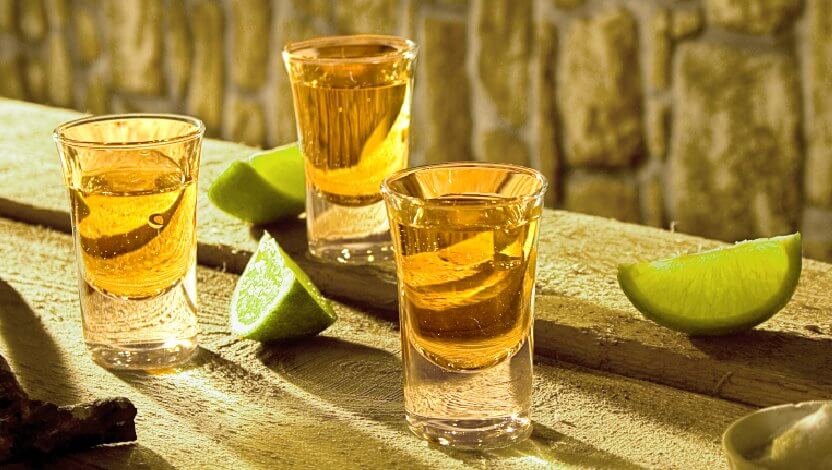
Tequila shots with lime
The student favorite – lip, sip, suck (a shot with salt and lime or lemon) – is a worthy fallback. But in all honesty, the tequila needed for this is likely to be the cheapest around. Don’t waste your prized sipping spirits here.
Mexicans, and one assumes that they might know something about this, enjoy it as bandera. In other words, they “drink the flag” (bandera meaning flag) by filling three shot glasses – one with lime juice, one with tequila blanco (the clear version), and the final one with sangrita (a popular Mexican drink of mixed juices and spices with as many versions as there are fans) – green, white and red! Bandera!
I have, however, been reliably informed that there are tequilas now considered quality spirits, designated for sipping – I will say that I swallowed this outrageous and obvious falsehood on an occasion many years ago, but in the interests of research once again I sallied forth.
In fairness, I am sure that there must be some stunning tequilas out there – no doubt horrendously expensive – but so far, they had eluded my rather meek attempts to locate them.
In its favor, one of my favorite authors, the wonderful Tom Robbins, described tequila as the drink of outlaws in Still Life with Woodpecker.
What is tequila?
There are five specific regions in Mexico in which tequila can be made: Guanajuato, Michoacán, Nayarit, Tamaulipas, and Jalisco. The latter by far the largest. A significant part of Jalisco has been deemed as a World Heritage site by UNESCO.
The blue agave, necessary for tequila production, prefers high altitudes and sandy, volcanic soils. The leaves can exceed seven feet and the stalks more than 16 feet, though if intended for commercial use the stalk is lopped off so the plant pours its efforts into its “heart.”
One stalk, a houseplant in Boston, reached more than nine meters – its owners were forced to cut a hole in the roof of their greenhouse to accommodate it. Pollination is by the greater long-nosed bat and occasionally insects and hummingbirds.
The blue agave – it cannot be any other sort of agave – is apparently a plant, not a cactus, and is closely related to the lily (which was news to me). Apparently, one needs to wait for almost a decade before it is ready for hand-harvesting, whereupon it is stripped to pulp and usually ground in a stone receptacle.
Tequila must be at least 51 percent blue agave; the remainder can be a neutral spirit. Many quality tequilas are 100 percent blue agave, which will certainly be detailed on the label. Otherwise, assume them to be only marginally so, and almost certainly cheaper and best destined for the cocktail bar.
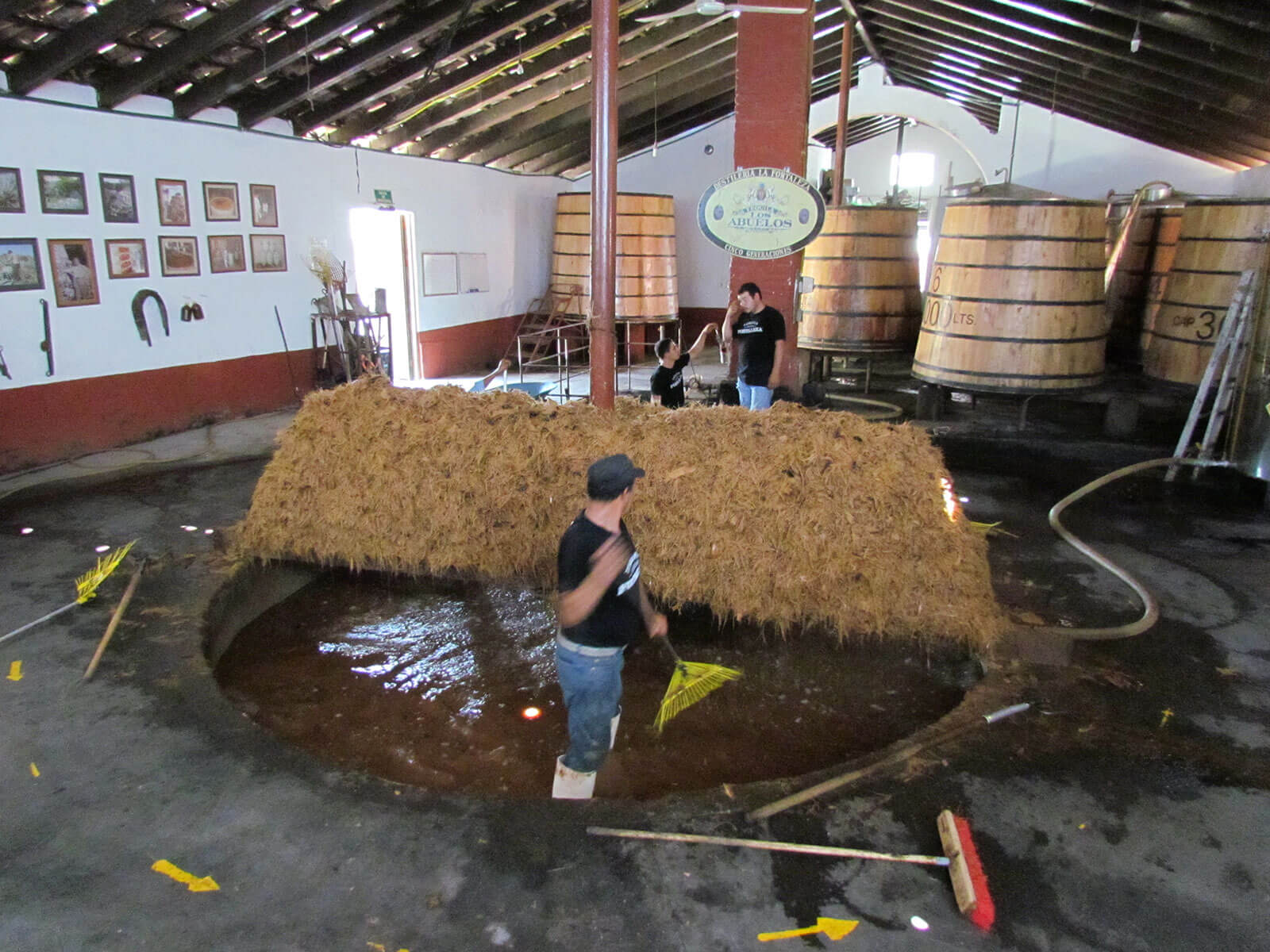
Blue agave pulp in the Destilería La Fortaleza in Tequila, Mexico
The blue agave works so well as the core of the plant has a high percentage of sugars, ideal for fermentation into alcohol. It is considered that plants grown in the highland regions yield sweeter, grassier and fruitier tequilas, while those from lower areas give forth an earthier flavor. Each plant can only be used once, unlike grape vines. Once harvested, an entirely new one will need to be grown.
I mentioned that the plant needed a decade before it was sacrificed to the altar of tequila. The actual period varies between seven and 14 years, at which time the heart is removed. It will weigh between 40 and 110 kilograms. It is stripped, roasted, and crushed to provide the sugary liquid used for fermentation and then distillation.
The latest stats, which date back to 2009, so please take them with a grain of salt (and lime and tequila), list more than 100 active distilleries, more than 900 brands, and more than 2,000 registered brand names.
The more famous brands are now mostly owned by large multinational corporations. Agreements, with reluctance, were put in place earlier this century to allow for bottling of tequila in the USA, though it still must come from the five designated areas.
In 2006, a class of tequila called extra añejo – “ultra-aged” – was introduced. These, obviously with an eye on the ever-expanding quality spirits market, must be aged for a minimum of three years.
At the other end of the quality spectrum, who among us has not deliberated over whether or not we should have a go at the worm. This is actually a marketing ploy – not traditional – and only found in a few mezcals. Never tequila – it is illegal to add the gusano (worm) to tequila.
Technically, mezcal is any spirit distilled from the agave plant, so tequila is a mezcal, but not all mezcals are tequilas as that spirit is restricted to the blue agave and the defined regions.
Occasionally, you might even find a mezcal with a scorpion. The worm is actually the larval form of the atlas moth that lives on the agave plant. It is far from good news if one is found during processing as any infestation leads to a poorer quality tequila.
There are four types of tequila.
Blanco/plata, meaning white/silver, is basically non-aged white spirit, bottled immediately after distillation or aged less than two months in stainless steel or neutral oak barrels. “Joven/gold” is also very young and gets its color from additions or possibly an extremely short time in barrel or even by being blended with older material.
Reposado (as in “rested”) will have been aged in barrels (size is irrelevant) for between two months and a year.
Añejo (meaning aged or possibly vintage) will have been aged between one and three years in small oak barrels; the Extra Añejo will have seen at least three years in oak barrels.
Overcoming kryptonite: tequila tasting notes
So can one overcome kryptonite? I have two tequilas to look at, which I am assured will change my world view of this spirit. I queried some American friends. They were aghast that I was not swimming in the stuff, such is their devotion. To each their own . . .
The first comes with what I first thought was a pineapple attached to the cork, but that is really a representation of the heart of the blue agave. It is from Fortaleza, a new brand launched in 2005, but by a family with tequila in its blood.
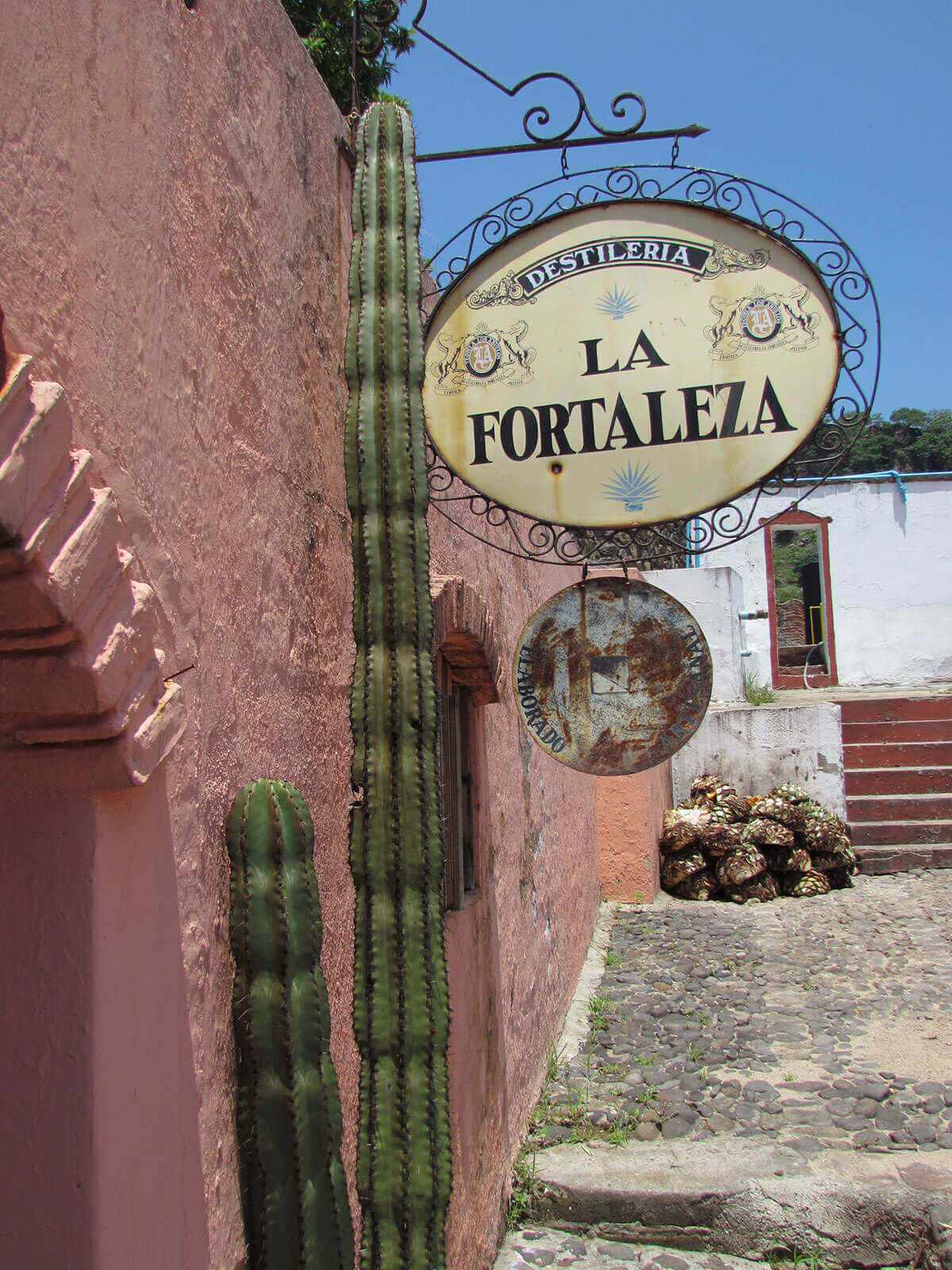
Destilería La Fortaleza in Tequila, Mexico
The current owner’s great-great-grandfather, Don Cenobio, founded his first distillery in 1873 in Tequila, Jalisco. His contributions to the development of tequila included using steam to cook the agave rather than earth pits. He was the first to export to the USA and he shortened the name from “mezcal de tequila” to simply “tequila.”
His son, Eladio, also established a distillery. Eladio’s son, Javier, was involved in the establishment of the denomination of origin for tequila after he was outraged to discover a bottle of “Japanese tequila” during his travels.
It was he who purchased the land and distillery that would become La Fortaleza, though it closed in the 1960s. In 1999, Javier’s grandson, Guillermo, revived the original distillery.
The Fortaleza Still Strength 46 Blanco (AUD$150) is gin-clear with lifted aromatics – crisp pears, green olives, spices, garden herbs, anise, possibly the merest whiff of honey, and more.
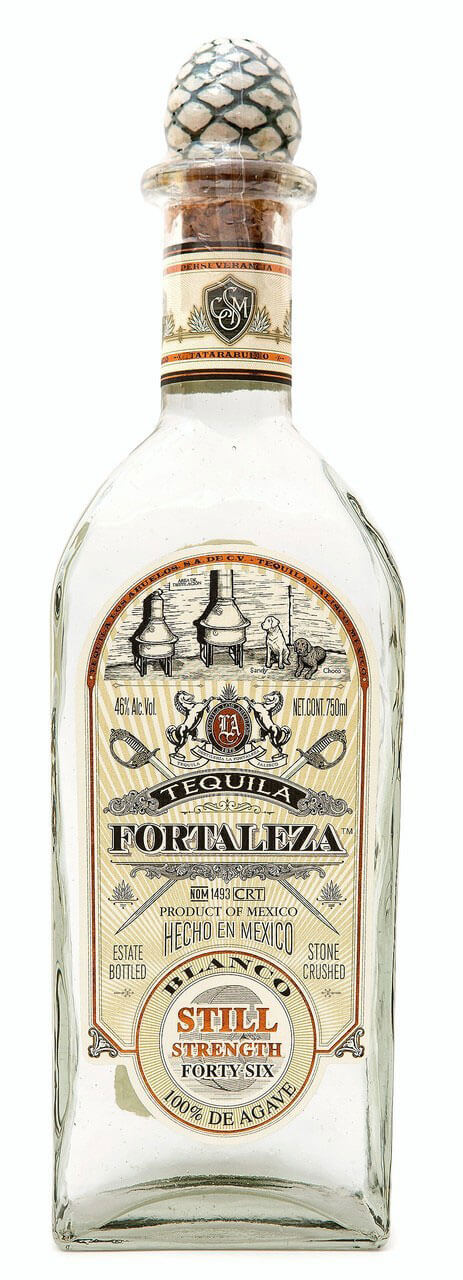
Fortaleza Still Strength Blanco tequila with representation of the blue agave heart attached to the cork
In wine terms, one might think sauvignon blanc notes. This is far from the slightly flavor-bland but fiery spirit one expects from the old “lip, sip, and sick” days.
Finely balanced and with weight and good texture. It is twice distilled from 100 percent blue agave and fermented in wooden vats. The clean finish, full of life and flavor, lingers with great persistence. This could easily be used as a sipping spirit.
Indeed, I would argue it should be used as a sipping spirit. Many speak of it being representative of the flavors of agave. Anyone doubting that tequila can be the smoothest, mellowest of spirits needs to get hold of a bottle of this as fast as possible. A quick glance around the internet reveals that this is indeed a very highly regarded tequila blanco, for many as good as it gets.
The name that is most often raised as a genuine competitor for that role is our second tequila.
The Calle 23 Criollo Tequila ($150) is from 100 percent blue agave, but with a slight difference.
Calle 23 is one of the newer producers, established by Sophie Decobecq, a French-born biochemist who moved to Mexico almost two decades ago while studying the science of fermentation. She fell in love with tequila and is now making her own. Decobecq is a firm favorite with mixologists around the world.
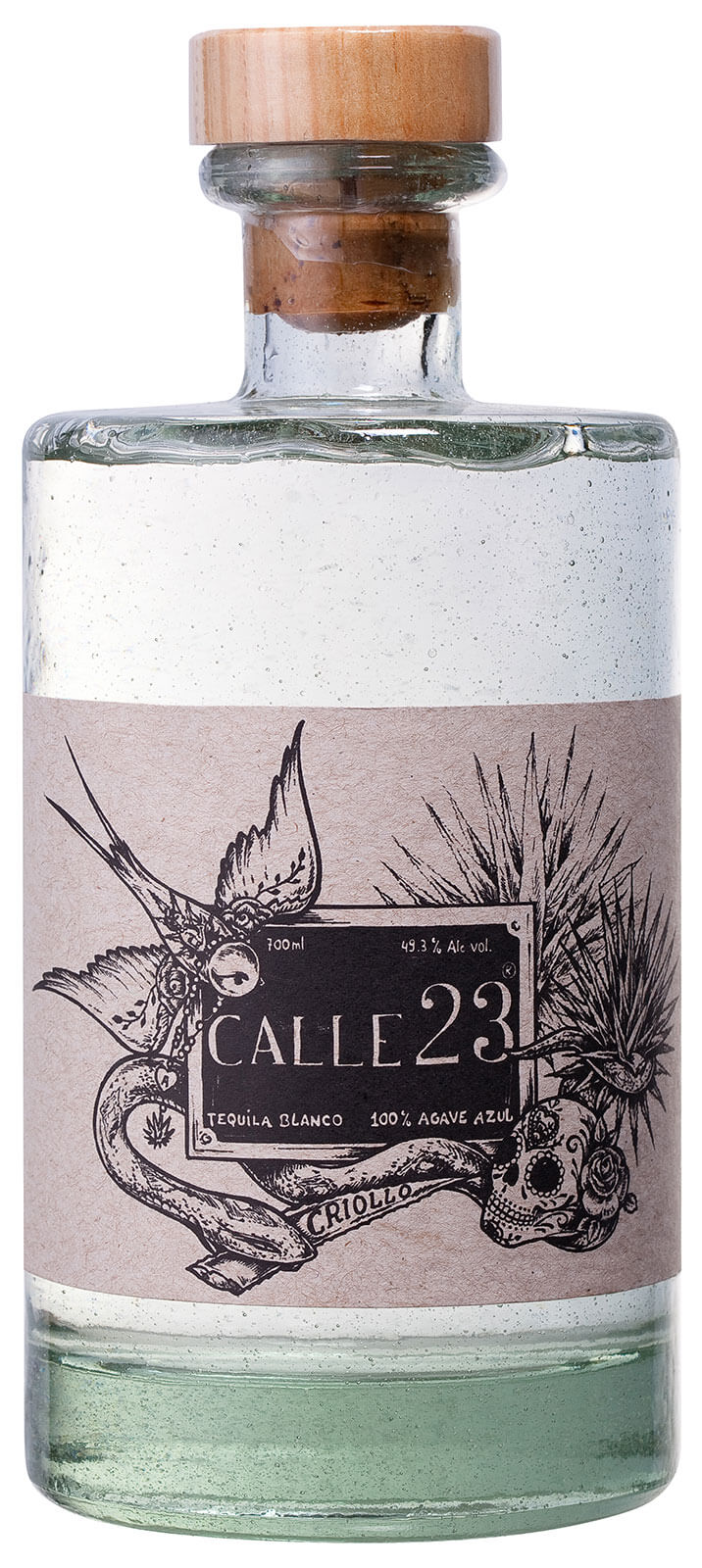
Calle 23 Criollo tequila
The Criollo is Sophie’s pride of the range, conceived at the time of the birth of her first son when she wanted to make something very special. She used only the “criollo” blue agave, which is normally blended with the “standard” blue agave. Basically, the criollo is an agave plant that is smaller than usual, providing an intense concentration of the natural sugars.
It is a lovely coincidence that criollo means “someone born in Spanish America but from European origin.” In English, think Creole. At 49.3 percent ABV the alcohol is higher than most, though it is not intrusive.
The flavors here are riper, darker fruits, more sweetness, black cherry notes, a hint of dark chocolate. Richer and sweeter, a little more rustic and perhaps a hint more spirity as one would suspect. Real depth of flavor. It has very good length, though perhaps not quite that of the Fortaleza. There is complexity to be found here.
Two cracking spirits and compelling evidence that tequila can sit with the finer offerings. It would come down to personal preference to make a choice between these two. If you prefer a more refined, elegant and sophisticated style then opt for the Fortaleza, whereas if bold flavors, richness, and a little more sweetness is your thing, the Calle 23 Criollo is for you.
Neither will disappoint.
No doubt there are many other fine tequilas out there. We look forward to any recommendations you may have.
For more information, please visit www.tequilacalle23.com and www.tequilafortaleza.com.
You may also enjoy:
Michter’s Kentucky Bourbon (Plus The Difference Between Whiskey, Whisky, And Bourbon)
Buffalo Trace Antique Collection Bourbon: Cult Treasure
Hine Antique XO Cognac: Not Compulsory To Enjoy With A Good Cigar . . . But Highly Recommended
Leave a Reply
Want to join the discussion?Feel free to contribute!



I have obviously drunk inferior Tequila many times but a few months ago in a fancy Mexican restaurant I tried an “aged” 100% blue agave tequila. It was….quite nice. I sipped it slowly, neat and tried to taste all of the notes and flavours. It was….slightly better than OK…and cost more than a good Single Malt.
I will not be repeating the experience.
I have tried every spirit I can find and have even found one (outrageously expensive) vodka which was lovely. Nothing can beat single malt whisky. Cognac comes second and well-aged Caribbean rum shares third place with those rare bourbons that truly sing. Tequila is….an entirely unnecessary endaevour.
thanks tam. i’d push great rum higher up the list but each to his own. for me, a great rum can sit next to the top malts, and has the added bonus of often being far better value.
In Shanghai there is (or used to be) a Rhumerie: a specialist Rum bar run by a beautiful French-speaking woman. We tried quite a few, including a 30 year old. There is a purity to rum which whisky doesn’t have. Rum has no..sleazy bitterness to it. But it also lacks the complexity of single malt, the vast array of flavours. Still, rum should be given far more respect than it is. I’d take a Mount Gay over a “Jack” any day!
hi tam, thanks for the thoughts.
the great rums really do excite me. i don’t believe i have ever had a better spirit than the isla del tesoro rum, for example. i do understand what you mean but i think the very best rums have their own style of complexity. but each to their own and i would be happy with either. as i have mentioned, the rums are usually better value, a big point for me and some, whereas others find that less of an issue.
as for calvados, no argument. there are an amazing number of great and underappreciated spirits out there. i’ll confess that grappa was my absolutely least favourite spirit – a nice way of saying i’d rather drink motor oil scraped up from a muddy floor under a rusty car. but then i was taken to a tiny (would make Sullivans Cove look like bacardi) producer up in the mountains behind the Veneto region. and wow. what he was doing was mindblowing. but such minute quantities. i’m sure you can find people like that in every category.
And let’s not forget calvados! Tried a 12 year old the other week. Very drinkable.